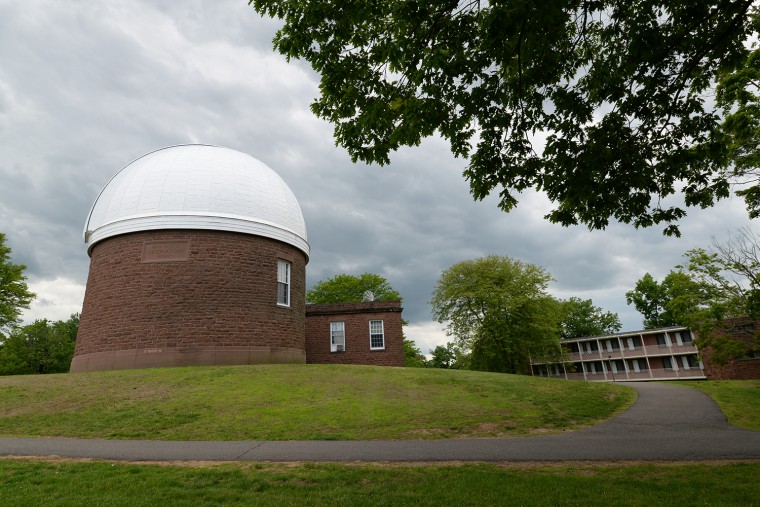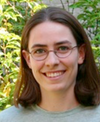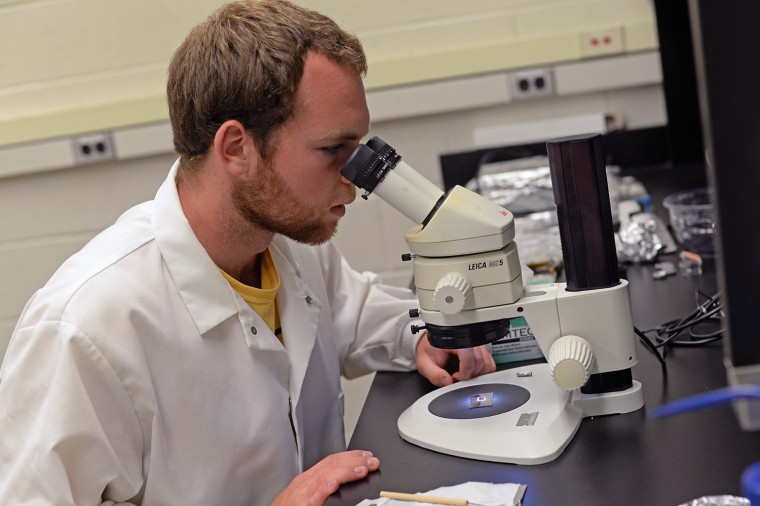Beginning Feb. 4, Wesleyan’s Van Vleck Observatory will open to the public every Wednesday night, rain or shine, for presentations by faculty and students on the latest space-related discoveries, as well as a chance for everyone to view the sky through a telescope, weather permitting. The program will start at 8 p.m. on Wednesdays. Presentations are intended to be accessible to visitors of all ages, although aimed primarily at high school level and above. (more…)
Martha Gilmore, the George I. Seney Professor of Geology, and her former graduate student Patrick Harner MA ’13 are the co-authors of a paper titled "Visible–near infrared spectra of hydrous carbonates, with implications for the detection of carbonates in hyperspectral data of Mars," published in Icarus, Vol. 250, pages 204-214, April 2015. The paper suggests that hydrous carbonate minerals might be relevant on Mars. "We bought and made these unusual minerals in my lab and then took spectra of them to simulate what Mars orbiters might see. Carbonate minerals form in water on Earth (e.g., limestones), and are predicted for Mars, but…
Jim Greenwood, assistant professor of earth and environmental sciences, was awarded a Faculty Seed Research Grant from the Connecticut Space Grant Consortium, supported by NASA. The honor comes with a $6,000 award. Greenwood will use the grant to support his research on “D/H of ‘Dry’ Extraterrestrial Materials.” Understanding the distribution, delivery, and processing of volatiles in the solar system is of fundamental interest to planetary science. Volatiles influence a number of important properties of planetary bodies, such as the cooling, differentiation, volcanism, tectonism, climate, hydrosphere/atmospheres and especially habitability. Greenwood will use the award to develop a new state-of-the-art inlet system for the measurement…
Jesse Lieman-Sifry '15 received a $5,000 Undergraduate Directed Campus Scholarship from the Connecticut Space Grant Consortium, funded by NASA. The award will be applied to his financial aid package and support his ongoing research in the Astronomy Department.
Assistant professor of Astronomy Meredith Hughes and eight colleagues have found evidence of magnetic fields in stardust – an indication that magnetic fields are important in the process of planetary system formation, according to a new paper in the journal Nature. The discovery is another step in work by Hughes and other astronomers to understand how celestial bodies are formed. It is known that magnetic fields in the “accretion disks” of stars play a dominant role in the star formation process. Using data from an observatory near Bishop, Calf., Hughes and her colleagues were able to spot signs of magnetic…
A July NASA report that a huge solar storm narrowly missed Earth in 2012 – avoiding catastrophic damage to energy, transportation and communications systems – has caused a media stir and some worry among Earthlings. What’s more, other recent reports say that Earth is overdue for a devastating storm of the kind known as a “Carrington event” after an 1859 storm that disrupted telegraph signals and caused other damage in a still-nascent industrial world. Named for 19th-century English astronomer Richard Carrington, it was the largest of its kind on record. A similar event now, in a world dependent on digital…
As a recent recipient of an undergraduate research fellowship, Jack Singer '15 is spending his summer at Wesleyan studying the geochemical evolution of the moon. The fellowship, supported by the Connecticut Space Grant College Consortium, comes with a $5,000 award. Grantees are expected to work on research related to space/aerospace science or engineering under the guidance of a faculty member or a mentor from industry. For the next three months, Singer will work on various research projects with his advisor James Greenwood, assistant professor of earth and environmental science. Singer will first prepare a fragmented lunar sample (Apollo 12035,76) for…
Biology Ph.D candidate Sarah Kopac was invited to speak at the 2014 Spring Symposium of the Space Telescope Science Institute on the campus of Johns Hopkins University in Baltimore, M.D. on April 29. Kopac spoke on "Specialization of Bacillus in the Geochemcially Challenged Environment of Death Valley." Watch a video of her 20 minute presentation online here. Kopac's talk was part of a four-day interdisciplinary meeting titled "Habitable Worlds Across Time and Space" featuring speakers from around the world working in such diverse fields as biology, geology and astronomy. The focus of the seminar was on identifying places within our…
Meredith Hughes, assistant professor of astronomy, received a grant from the National Science Foundation to support her research on "Dust and Gas in Debris Disks Reveal the Origins of Planetary Systems." The grant, awarded on April 21, is worth $532,943. Hughes’ research focuses on understanding the formation and evolution of planetary systems. She particularly studies the huge disks of gas and dust surrounding a young star, which can give insight into how and when a star planet might form. The disk is made up of “junk” left over from the star’s formation. The main technique Hughes uses to observe these circumstellar…
Assistant Professor of Earth and Environmental Sciences James “Jim” Greenwood has received a $331,000 grant from NASA to support his research on the moon’s water. His proposed research, tracking water in rock samples brought back by the Apollo missions, will “take a giant leap towards solving one of the most important questions in planetary science – whether the Moon is wet or dry,” Greenwood said. “We’ll be studying pockets of glass trapped in early and late-crystallizing minerals in lunar mare basalt samples,” Greenwood said. “We will measure water and other volatile elements in these trapped melt pockets to reconstruct the…
With his Wesleyan undergraduate and graduate students, Assistant Professor of Astronomy Seth Redfield studies exoplanets, the local interstellar medium, and stellar and exoplanetary atmospheres. He talks about the unique opportunity offered through his exoplanet program at Wesleyan, in which students at the undergraduate level participate in cutting-edge research. [youtube]http://youtu.be/PNP5Cgc10go[/youtube] #THISISWHY
James "Jim" Greenwood, assistant professor of earth and environmental sciences, and four colleagues have published a paper that casts doubt on the theory of abundant water on the moon while simultaneously boosting theories around the creation of the moon, several billion years ago. The paper, “The Lunar Apatite Paradox,” published March 20 in the prestigious journal Science, stems from work involving the mineral apatite, the most abundant phosphate in the solar system. (Along with its presence on planets, it’s found in teeth and bones.) Initial work on the lunar rocks brought back to Earth by the Apollo missions indicated that…






